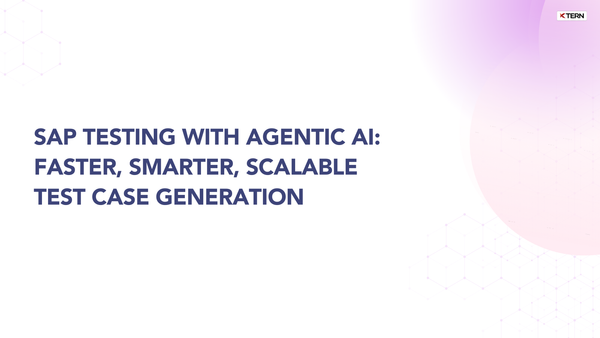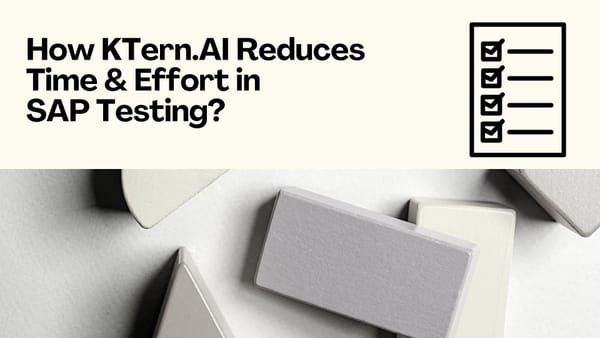5 steps to simplify your SAP Functional & SAP UAT Testing
Today, enterprises running on SAP are consistently tasked with ensuring high quality end-to-end business processes. Increasingly, they also become committed to continual change. However, the result is added complexity while maintaining business process quality. In addition, SAP test managers are faced with tremendous pressure to reduce time-to-market cycles in a competitive market. Moreover, with usage of SAP systems increasing among laymen, they struggle to standardize test management and accelerate test execution. This Articles focuses on how one can simplify SAP Functional and SAP UAT Testing.
These two, equally important endeavors – change and quality - require extensive and effective SAP functional testing, across all business-critical SAP applications. However, as extensive and effective as it may be, functional testing cannot and should not be a bottleneck to releasing change.
To meet quality standards when implementing continual change, organizations need a centralized tool, where all test activities can be managed, executed and tracked. Business process perfection and continual change are not mutually exclusive. A rethink of methodology and the right test management tool can help you win on both fronts.

Table of contents
- What is SAP Functional Testing?
- Steps to simplify SAP testing
- Step 1: SAP Test Automation
- Step 2: Ensure Business Process alignment
- Step 3: Collaboration
- Step 4: Optimization through complete visibility
- Step 5: Always be audit-ready
- KTern’s Digital Labs
- Next steps
What is SAP Functional Testing?
SAP Functional testing is nothing but the validation of SAP software against functional requirements and specifications. Its purpose is to test each function of SAP by providing the appropriate input and verifying the output with respect to the functional requirements. Typically, the functional testing is followed by non-functional testing which checks the performance, reliability and scalability of the system.
Types of functional testing in SAP include:
- SAP Unit Testing
- SAP Smoke Testing
- SAP Integration Testing
- SAP User Acceptance Testing
- SAP Regression Testing, etc.
However, as discussed above, SAP functional testing has several challenges.
Steps to simplify SAP testing
The below five steps can help to streamline and simplify the testing process.
Step 1: SAP Test Automation
Today’s competitive marketplace dictates both the fast pace of change and the high standards for quality. In this reality, test automation is no more a choice but a mandate for organizations.
A functional testing tool must support the management of test automation scripts from a single repository. However, that is not enough for a test execution project. Test automation needs to be an integral part of the entire execution process.
Automation elements should be brought into the manual testing and governance process as well.
Features like automatic sequencing of manual tests, automatic capturing of test results, auto- creation of test scripts and all of the above’s on-demand availability via a single platform are essential.
Step 2: Ensure Business Process alignment
To ensure that any change to an application will function correctly at go-live, test cycles must be validated with business process awareness, leveraging the knowledge of subject- matter experts, who might be cross-functional and geographically dispersed.
SAP testing platforms need to support this model with business process-centric management and monitoring throughout the test lifecycle – test planning, test execution and test validation. This reflects into the creation of test scripts, planning of workflows, assignment of testers, sequencing of the execution and reporting on the quality and completion of business processes. It further provides test managers and business owners with full visibility into the overall quality and status of business processes.
Here is an example to the value and necessity of business process testing. While technical testing would confirm that a new purchase order now includes a subfield for internet orders, business process testing will ensure that the same purchase order works throughout the entire Purchase-to-Pay (P2P) business process. The new purchase order format should function correctly as of its initial creation, through to approval, goods receipt, invoice creation, and finally to accounting.
A new code change may be bug-free and even fully functional within its own element. However, business process functional testing qualifies the change to the daily business. The testers may confirm that no defects or risks are found when the new code change is applied to a specified business process. But test validation depends on multiple users, steps, functions and geographies. Such an SAP testing process is indispensable in ensuring that no bugs slip into production and negatively impact the customer experience.
Step 3: Collaboration
In today’s global economy, enterprise SAP testing solutions are gaining adoption by different and geographically distributed business users.
Subject-matter experts (SMEs) adoption is too often hindered by tools that are technically impossible to align with Quality Assurance (QA) parties, resulting in miscommunication and duplicated efforts, which in turn reduce efficiency and later on can even cause business process failure.
A winning SAP testing tool must support collaborative communication between QA, testers, developers and subject-matter experts for joint reviews and the detection of early errors.
Collaboration tools are vital when it comes to test-execution and monitoring workflows that minimize idle time and remove the bottlenecks of testing. For example, the project manager should be able to assign testers to a particular test case or business process from within the application, ‘Retest’ notification should be sent to testers upon defect resolution and ‘Close’ notification to developers upon retest success. This applies to all business-processes impacted by a single defect.
Only a proactive, collaborative, system-wide approach to test and defect management ensures a quick and efficient SAP testing cycle, with built-in quality assurance.
Step 4: Optimization through complete visibility
As the complexity of SAP platforms increases, testing your applications becomes more crucial and at the same time, more difficult. Clearly, the pressure is on testing managers to deliver production-ready applications quickly. But how can you stay in control of a continual develop-test-fix-and-release cycle?
Most SAP migration/transformation projects fail due to the lack of proper visualization of analytical data related to a project’s progress. In the absence of a centralized tool, the entire process of reporting is dependent on manual interactions, making it error-prone.
The only solution is total visibility across projects, teams, and tests. You must choose a tool that lets you know how done you really are – at every phase of the project. The tool should provide real-time reports and dashboards that convey testing status and track overall team progress across test projects, cycles and business processes.
To stay on top of their game, test managers must gain full visibility of test plans, cases, scenarios, as well as defects - in a single platform. Based on their insights from this information, they should be able to centrally manage the SAP testing activities. Visibility in monitoring test workflows – based on end-to-end business processes - enables managers to easily identify and remove workflow bottlenecks.
A useful test management tool should monitor test velocity and testers’ individual workloads to make sure everyone meets their defined scope. Other nice-to-have features include monitoring of planned vs. actual reporting by team or by tester.
Step 5: Always be audit-ready
Compliance is an integral part of SAP testing and with the need to audit or simply track quality assurance processes, test documentation becomes critical, for both execution and defect resolution. Many traditional tools lack documentation capabilities.
Having users manually document their tests (with print screens and cut - paste evidence) is an inefficient, and time-consuming process that is open to inaccuracies. Similarly, a constant back and forth between developers and testers for test reproduction is non-scalable and counterproductive.
To maintain quality standards, Testing parties must always be audit ready.
An ideal test management tool should therefore offer automatic and very detailed testing documentation that can be used for audits, training and user guidance. Test automation provides a detailed, reusable and audit-ready document of each and every test - generated effortlessly ‘on the fly.’
KTern’s Digital Labs
Including these five key features in your requirements for a test management tool would ensure greater subject-matter expert adoption, better ROI, less bottlenecks and most importantly, total visibility into your cross-organization, multi-geography testing project.
It’s important to choose a tool that mirrors the way your organization works throughout an end-to-end business process. In as much as your operations require automation, collaboration, visibility, compliance and process – your test management method should reflect it. KTern’s Digital Labs is an end-to-end test management solution, built specifically for SAP Digital Transformation projects, that offers all five key elements mentioned above. It delivers 30% to 40% reduction in testing effort.
KTern’s Digital Labs has the following salient features:
- Built on SAP’s Activate framework, specifically for SAP transformation projects
- An in-built AI based S/4HANAPEDIA rule engine
- Value, Volume and Velocity (VVV) based auto test case recommendations
- Auto test case executions and defects repository
- Tightly integrated project management capabilities
- 30% - 40% reduction in total project cost and timeline
Next steps
You might want to get a first-hand feel of KTern’s Digital Labs and its several other modules which help automate and govern SAP projects from start to finish.
If you would like a guided demo of the product from one of our product engineers, kindly get in touch with us by submitting a message at Contact Us




